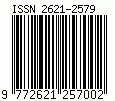Analysis of a Persuasive Video on YouTube: A Collaboration between the Indonesian Ministry of Health and the Nahdlatul Ulama to Promote COVID-19 Vaccination in Indonesia
DOI:
https://doi.org/10.12928/channel.v11i1.250Keywords:
persuasive video, COVID-19, Nahdlatul Ulama, vaccinationAbstract
The COVID-19 pandemic in Indonesia led to the collapse of national health facilities and the economy, which resulted in the acceleration of the invention of COVID-19 vaccines. However, only 54.9% of the population is willing to be vaccinated due to fake news or hoaxes. The government urges the public to obey regulations, especially in public spaces, and intensifies socialization through various media, such as YouTube. This study aims to determine the critical elements that compose the video on the YouTube channel so that it can be used as a medium to persuade the wider community. This study used qualitative methods to collect visual and textual data from purposively selected videos and screenshots, which were analyzed using communication theory for persuasion and a constructionist approach to interpret the data and identify variables such as the message's source, characteristics of the recipient, and purpose of the message. The Indonesian Ministry of Health and the Nahdlatul Ulama Executive Board collaborated to create a 2-minute, 53-second video on the importance of vaccination in Indonesia, particularly for Muslims. The video features PBNU's Health Head, dr. Syahrizal Syarif effectively educates the public on vaccination's significance and emphasizes community unity to support the government's vaccination program. The communicator in the video successfully positioned himself as a religious leader and doctor. The video is effective in communicating three key messages. It uses persuasive communication theory, using YouTube's power to influence people's opinions, suggesting that the government should use digital platforms to deliver more messages to the citizens in the future.
References
Adyatama, E. (2021). Survei: Masih Banyak Warga Tak Percaya Data Covid-19 dari Pemerintah. Retrieved November 5, 2021, from https://nasional.tempo.co/read/1493802/survei-masih-banyak-warga-tak-percaya-data-covid-19-dari-pemerintah
Ardianto, E. (2011). Komunikasi 2.0 Teoritis dan Implikasi. Yogyakarta: ASPIKOM Buku Litera dan Perhumas. ISBN: 978-602-98226-7-0
Bastaman, W. W., Fauzi, R., & Bahri, S. (2021). Pemanfaatan Media Internet pada Masa Pandemi Covid 19 Sebagai Sumber Belajar Mahasiswa Program Studi Pendidikan Sejarah pada Matakuliah Sejarah Islam di Indonesia. Jurnal Kala Manca, 9(2), 15–23. https://jurnal.stkipsetiabudhi.ac.id/index.php/kalamanca/article/view/80
Bilal, M. (2021). A Religious and Political Leader Maulana Fazal-Ur- Rahman’s Persuasive Strategies Used in Million March Speech 2019 : A Cda Approach Based on Fairclough ’ S Framework. PalArch’s Journal of Archaeology of Egypt / Egyptology, 18(4), 1326-1341. Retrieved from https://archives.palarch.nl/index.php/jae/article/view/6477
Daud, R. F., Apriliani, D., & Kusuma, A. R. D. (2021). Forms of Instagram Social Media Communication in Promoting Lampung Province Tourism. CHANNEL: Jurnal Komunikasi, 9(2), 149-158. https://doi.org/10.12928/channel.v9i2.21053
Flew, T. (2002). New Media: An Introduction. New York: Oxford University Press. ISBN: 9780195550412
Franedya, R. (2020). 1,2 Juta Vaksin Tiba di RI, Kapan Vaksinasi Covid-19 Dimulai? Retrieved March 13, 2023, from https://www.cnbcindonesia.com/tech/20201207071122-37-207215/12-juta-vaksin-tiba-di-ri-kapan-vaksinasi-covid-19-dimulai
Gast, D. L. (2010). Single Subject Research Methodology in Behavioral Sciences (Paperback). New York: Routledge. ISBN 978—0-8058—6277—5
Goldie, C. M., & Pinch, R. G. E. (1991). Communication Theory. In P. G. and E. de B. Denis McQuail (Ed.), Communication Theory. https://doi.org/10.1017/cbo9781139172448
Graeff, Judith A., John P. Elder., & E. M. B. (1996). Komunikasi untuk Kesehatan dan Perubahan Perilaku. Yogyakarta: Gadjah Mada University Press. ISBN: 979-420-384-X
Hall, S. (2003). Cultural Representations and Signifying Practices (2nd editio). Retrieved from https://uk.sagepub.com/en-gb/eur/representation/book234567
Hastuti, S. (2013). Efektivitas Iklan Layanan Masyarakat di Televisi. Jurnal Ilmu Komunikasi, 2(2), 67–71. https://jkms.ejournal.unri.ac.id/index.php/JKMS/article/view/2554
Hernikawati, D. (2021). Analisis Dampak Pandemi COVID-19 terhadap Jumlah Kunjungan pada Situs E-Commerce di Indonesia Menggunakan Uji T Berpasangan. Jurnal Studi Komunikasi Dan Media, 25(2), 191. https://doi.org/10.31445/jskm.2021.4389
Kaelan. (2012). Metode Penelitian Kualitatif Interdisipliner Bidang Sosial, Budaya, Filsafat, Seni, Agama dan Humaniora. Yogyakarta: Paradigma. ISBN: 978-979-8658-08-2
Kusnandar, V. B. (2021a). Pengguna Internet Indonesia Peringkat ke-3 Terbanyak di Asia. Retrieved November 6, 2021, from https://databoks.katadata.co.id/datapublish/2021/10/14/pengguna-internet-indonesia-peringkat-ke-3-terbanyak-di-asia
Kusnandar, V. B. (2021b). Sebanyak 86,88% Penduduk Indonesia Beragama Islam. Retrieved November 6, 2021, from https://databoks.katadata.co.id/datapublish/2021/09/30/sebanyak-8688-penduduk-indonesia-beragama-islam
Leech, G. (2014). The Pragmatics of Politeness. New York: Oxford University Press. ISBN: 9780195341386
Lidwina, A. (2021). 94% Orang Indonesia Akses YouTube dalam Satu Bulan Terakhir. Retrieved November 6, 2021, from https://databoks.katadata.co.id/datapublish/2021/02/17/94-orang-indonesia-akses-youtube-dalam-satu-bulan-terakhir
Majni, F. A. (2021). Survei: 41% Masyarakat Masih Kurang dan Tidak Bersedia Divaksin. Retrieved November 7, 2021, from https://mediaindonesia.com/humaniora/386234/survei-41-masyarakat-masih-kurang-dan-tidak-bersedia-divaksin
Martinus, Y. (2020). Disiplin Masyarakat Masih Rendah, Doni Monardo: Kita Sekarang Harus Jadi Orang Cerewet. Retrieved March 13, 2023, from https://wartakota.tribunnews.com/2020/06/18/disiplin-masyarakat-masih-rendah-doni-monardo-kita-sekarang-harus-jadi-orang-cerewet
Masyrafina, I. (2021). Sebanyak 42 juta orang Telah Divaksinasi Covid-19. Retrieved March 13, 2023, from https://news.republika.co.id/berita//qwkx5m380/sebanyak-42-juta-orang-telah-divaksinasi-covid-19
Notoatmodjo, S. (2007). Kesehatan Masyarakat Ilmu dan Seni. Jakarta: Rineka Cipta. ISBN: 9780195341386
Ott, B. L. (2017). The age of Twitter: Donald J. Trump and the politics of debasement. Critical Studies in Media Communication, 34(1), 59–68. https://doi.org/10.1080/15295036.2016.1266686
Perloff, R. M. (2020). The Dynamics of Persuasion Communication and Attitudes in the Twenty-First Century (7th Editio). London: Routledge. ISBN: 9780367185794
Prabowo, D. L., Salim, M., Hariyanti, N., Marta, R. F. (2022). Pengaruh Terpaan Tayangan Video YouTube Otodriver. com Terhadap Asosiasi Merek Mobil Pada Pengikut Akun. Jurnal Audience: Jurnal Ilmu Komunikasi 5 (1), 95-110. http://publikasi.dinus.ac.id/index.php/audience/article/view/5797
Pranita, E. (2021). Apa Fungsi Tripsin Babi yang Disebut MUI Ada di Vaksin AstraZeneca? Retrieved November 5, 2021, from https://www.kompas.com/sains/read/2021/03/20/170200623/apa-fungsi-tripsin-babi-yang-disebut-mui-ada-di-vaksin-astrazeneca?page=all
Pratkanis, A. R., & Aronson, E. (2001). Age of Propaganda. California: Henry Holt and Company. ISBN-13: 978-0805074031
Purnamasari, O., Ardia, V., & Handoko, D. (2018). Persuasive Communication Pattern of Public Service Announcement, A Highlight of Cancer Education by Indonesia Government in Television. Malaysian Journal of Social Sciences and Humanities (MJSSH), 3(1), 52–61. Retrieved from https://msocialsciences.com/index.php/mjssh/article/view/58
Putri, P. K. (2016). Aplikasi Pendekatan-Pendekatan Persuasif Pada Riset Komunikasi Pemasaran: Iklan Melibatkan Penciptaan dan Penerimaan Pesan Komunikasi Persuasif Mengubah Perilaku Pembelian. Jurnal The Messenger, 8(1), 1-16. https://doi.org/10.26623/themessenger.v8i1.313
Salim, M., Utami, F. U., Bramantyo, H. (2021). Digital Media-Based Nutrition Health Communication Model. 3rd Jogjakarta Communication Conference (JCC 2021). 247-251. https://www.atlantis-press.com/proceedings/jcc-21/125964693
Salim, M., Wibowo, A. A., Hariyanti, N. (2023). Kajian Kebijakan Komunikasi Kesehatan Global Terkait Vaksinasi COVID-19. Komunikasi dan Isu Global Kontemporer. 83-98. Penerbit Samudra Biru. ISBN: 978-623-261-557-1
Sandi, A. F., Wibowo, A. A., Nugrahani, R., & Nasir, R. M. (2022). Analysis of Twitter User Responses to the Aqua Billboards Series #DiRumahAJa. CHANNEL: Jurnal Komunikasi, 10(1), 27–34. https://doi.org/10.12928/channel.v10i1.22332
Sugiyono. (2018). Metode Penelitian Kualitatif. Bandung: Alfabeta. ISBN: 978-602-289-533-6
Downloads
Published
How to Cite
Issue
Section
License
Copyright (c) 2023 CHANNEL: Jurnal Komunikasi

This work is licensed under a Creative Commons Attribution-ShareAlike 4.0 International License.






